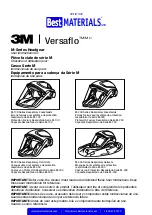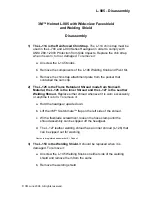
FV533 Rev. A 1/13/11
Page 2
PRIOR TO INSTALLATION
Prior to installing the ZTS6200 series flushometer valve,
install the items listed below:
• Fixture
• Drain line
• Water supply line
IMPORTANT:
• All Plumbing is to be installed in accordance with applicable
codes and regulations.
• Water supply lines must be sized to provide an adequate
volume of water for each fixture.
• Flush all water lines prior to operation (See Step 2).
• Dirt and debris can cause flush valve to run continuously.
• Sensor units should not be located across from each other or
in close proximity to highly reflective surfaces.
The ZTS is designed to operate with 40 to 116 psi static water pressure. Protect the chrome or special finish of this flushometer.
Do not use toothed tools to install or service the valve.
1.)
Install stop valve assembly
(A)
using proper size supply
escutcheon and sweat solder adapter kit if applicable. Thread
sealing compounds should be used on male NPT threads
only.
See Figure 1
5.)
Prior to inserting the flush valve tailpiece
(B)
into stop valve
(A)
, be certain that the O-ring seal
(C)
is located in O-ring
seal groove at the end of the tailpiece and that the locking nut
(D)
and locking snap ring
(E)
are located as shown. Care
should be taken not to damage the O-ring when inserting
the tailpiece into the stop valve. If lubrication is needed, wet-
ting the O-ring with water will be sufficient. Tighten all con-
nections with a non-toothed wrench.
See Figure 5
Figure 1
E
C
A
D
Before the supply water is turned on, be sure all stop valves are
closed off tight. The stop valves can be opened and closed by
using the adjusting screw
(S)
located at the center of the stop
valve cap
(T)
. Stop valve adjustments can only be made by us-
ing the adjusting screw
(S)
.
It is not necessary to remove the
stop valve cap (T) when making adjustments. If for any rea-
son it becomes necessary to remove the stop valve cap (T),
be certain the water is shut off at the main supply valve.
See
Figure 2
T
S
Figure 2
Figure 3
3.)
Install battery into cap. *
Note: Do not remove lens label at
this time.
This is to prevent the sensor from inadvertently
going into calibration mode.
4.)
After battery is installed, connect solenoid to electronics and
place cap on valve body.
*Note: Install cap with care and insure wires are not pinched
or damaged. This can cause the valve not to function prop-
erly.
Once cap is securely emplaced on the valve, install the set
screw to lock the cap on the valve. Tighten set screw with
allen wrench provided.
B
A
2.)
When all stops are connected to the water supply and
water pressure is available, it is recommended that the
supply piping be flushed to remove dirt, metal chips, etc.,
from system.
A. Before the valve is installed, open each stop fully for a brief
time and catch the water in a two gallon or larger bucket. For
multiple installations, start with the stop valve closest to the
water supply and work toward the most remote valve.
B. Due to the small passages and orifices, it is not possible to
flush the piping through the low volume valve.
C. Once the lines are flushed, the valve can be installed.
Figure 4
Figure 5
























